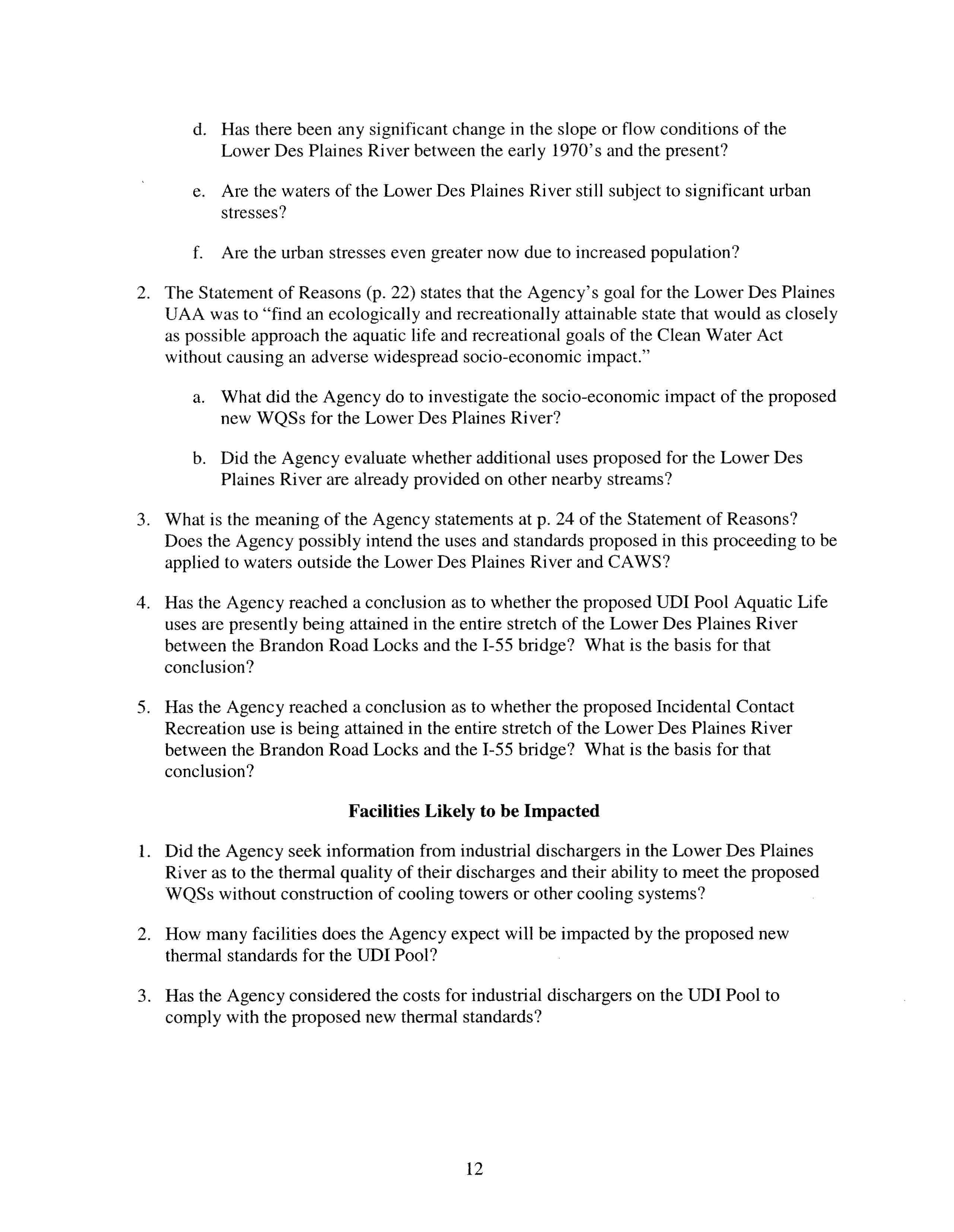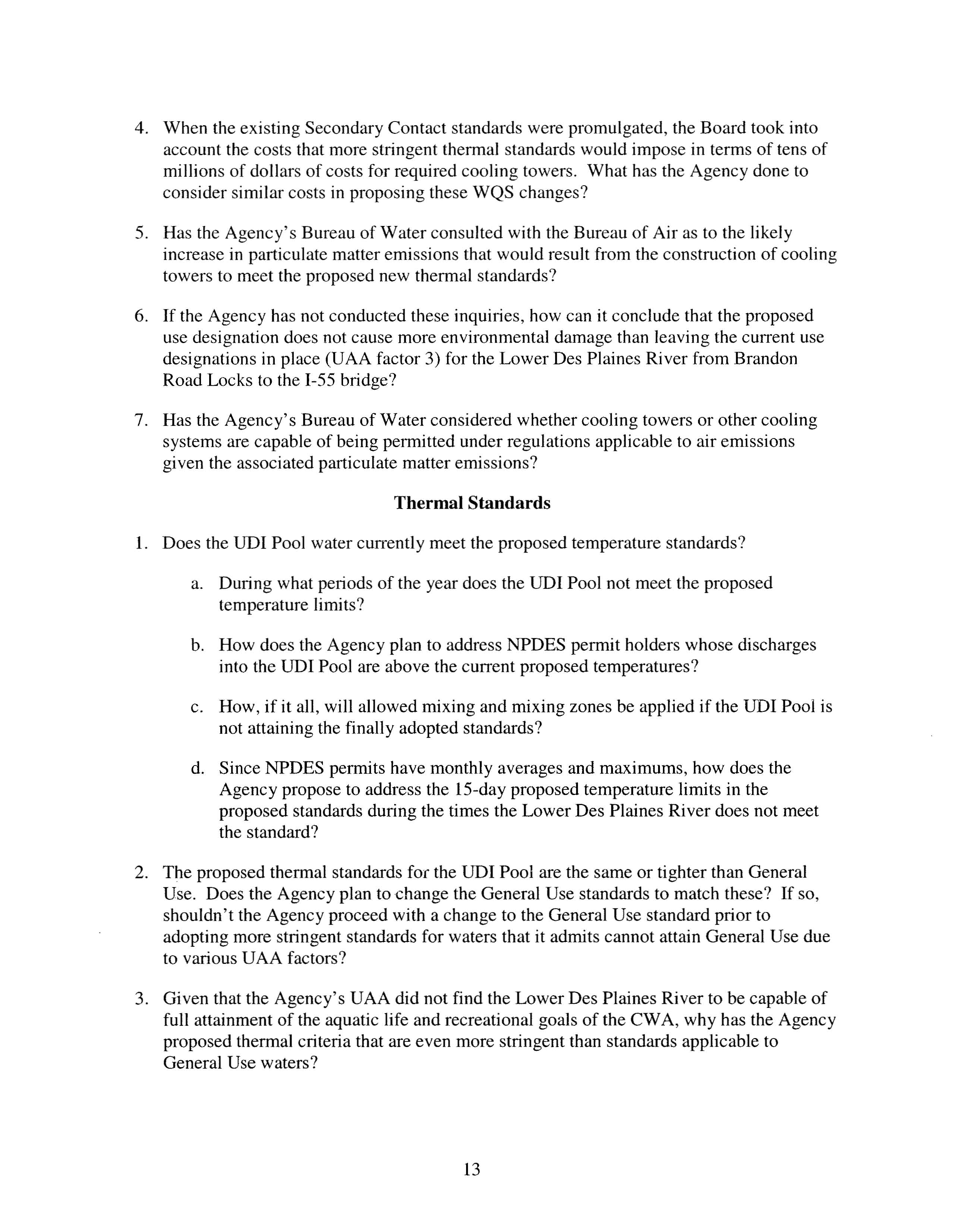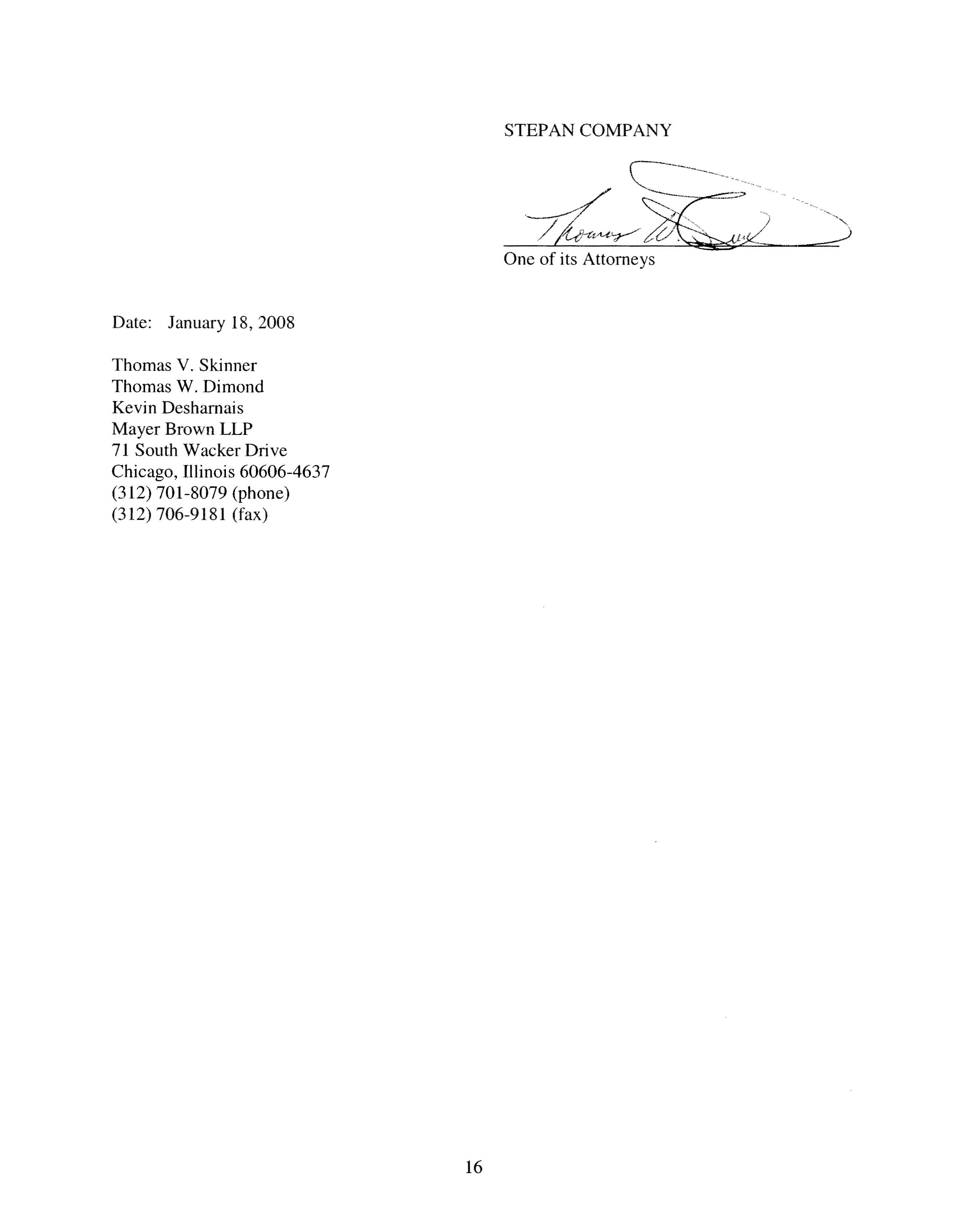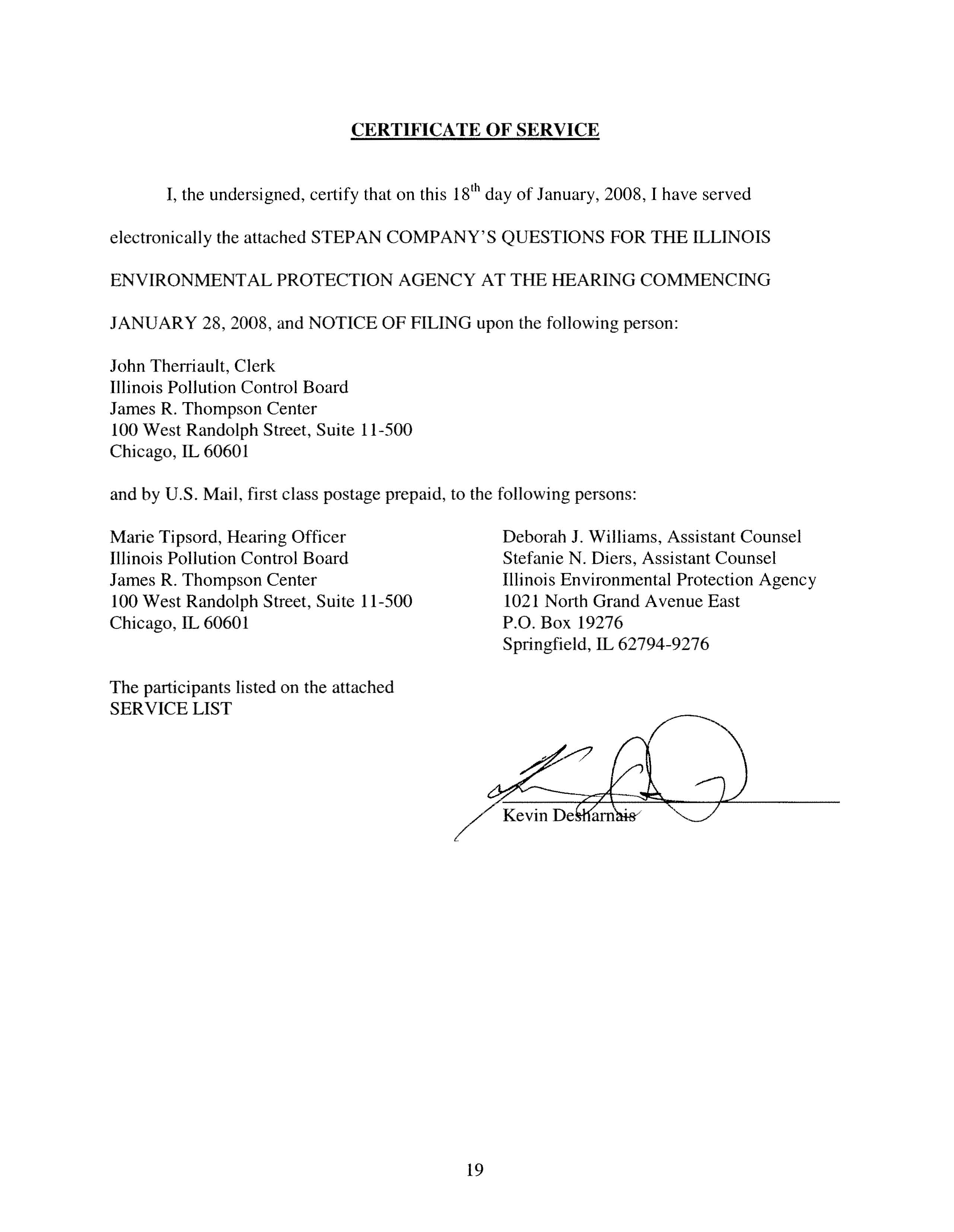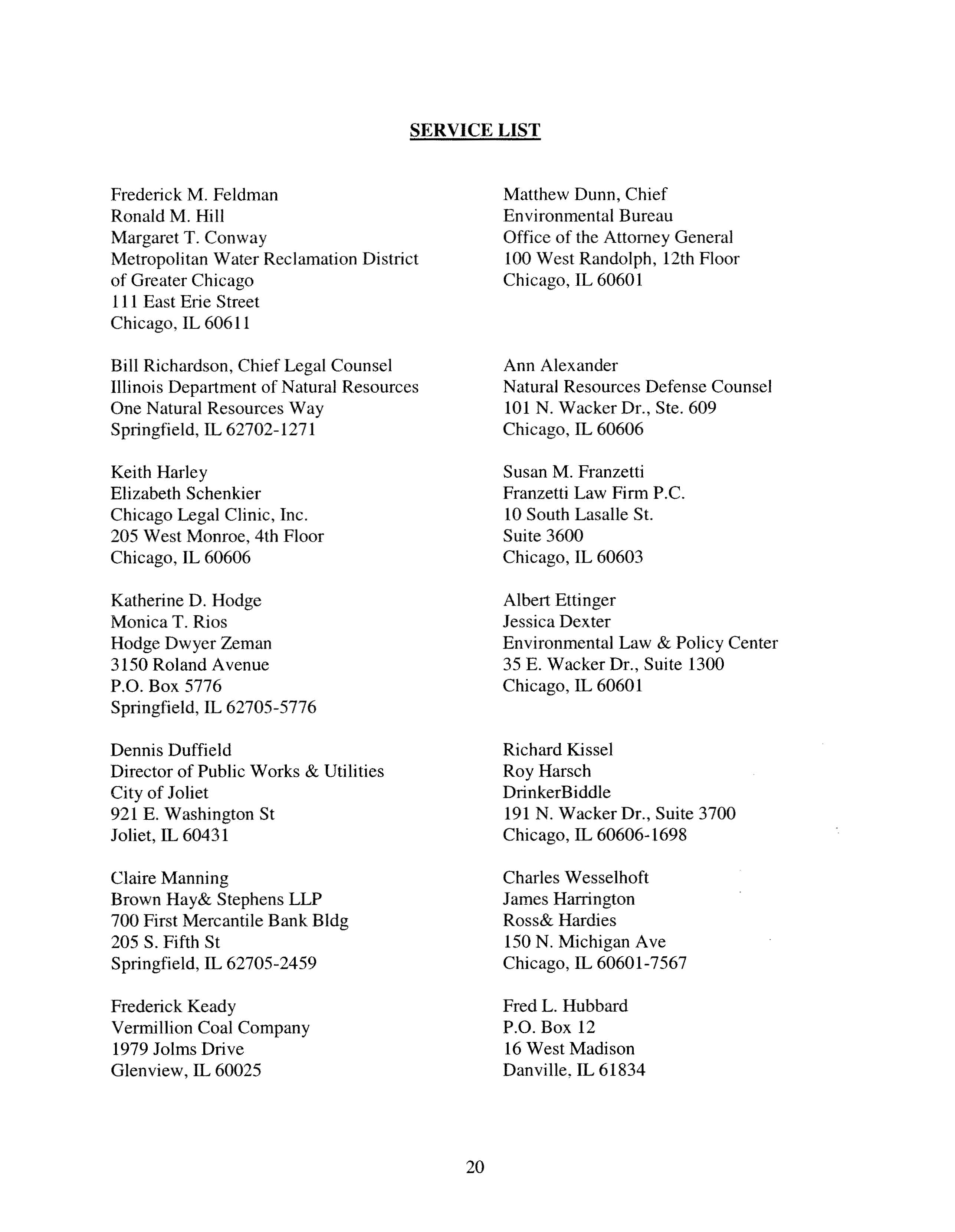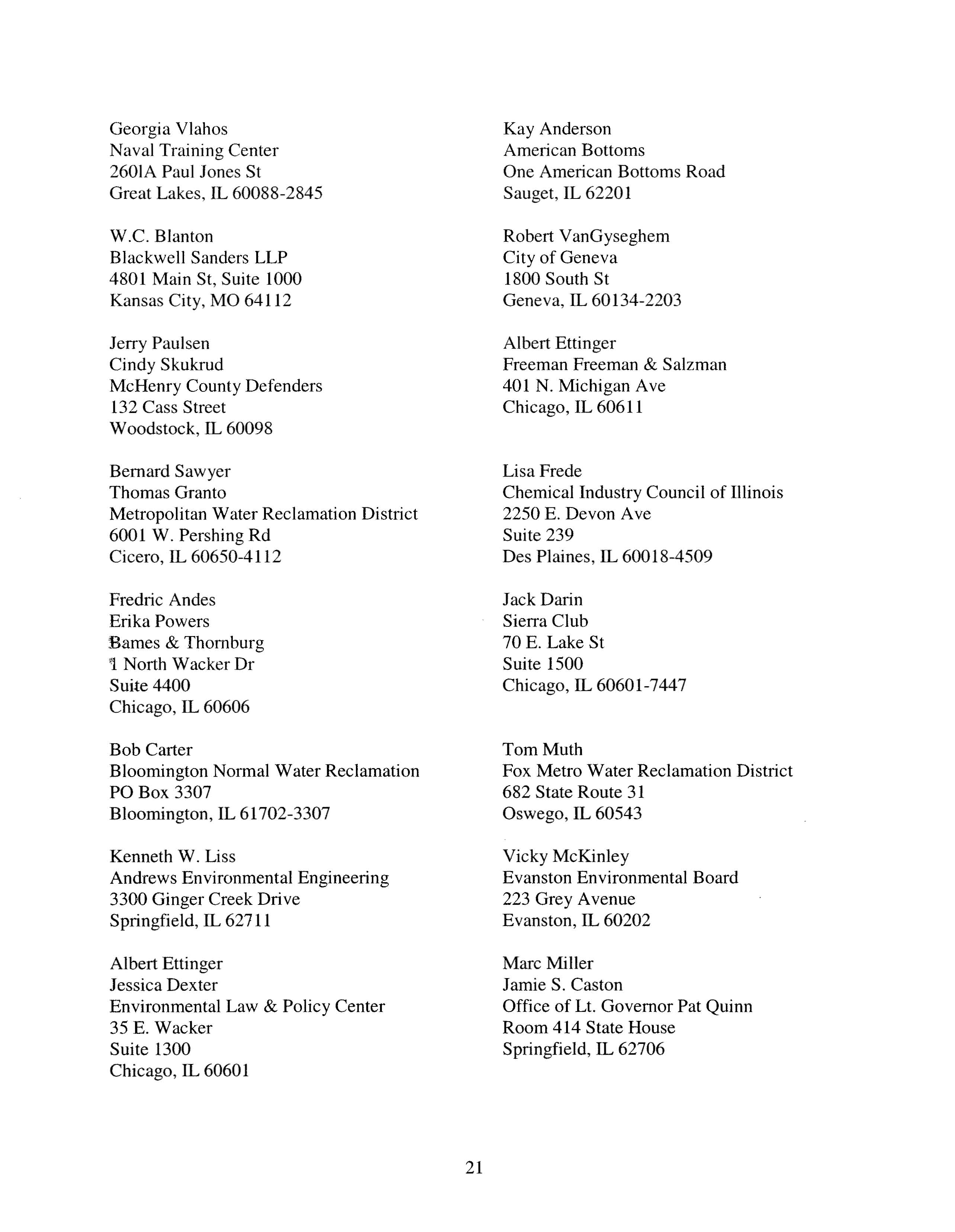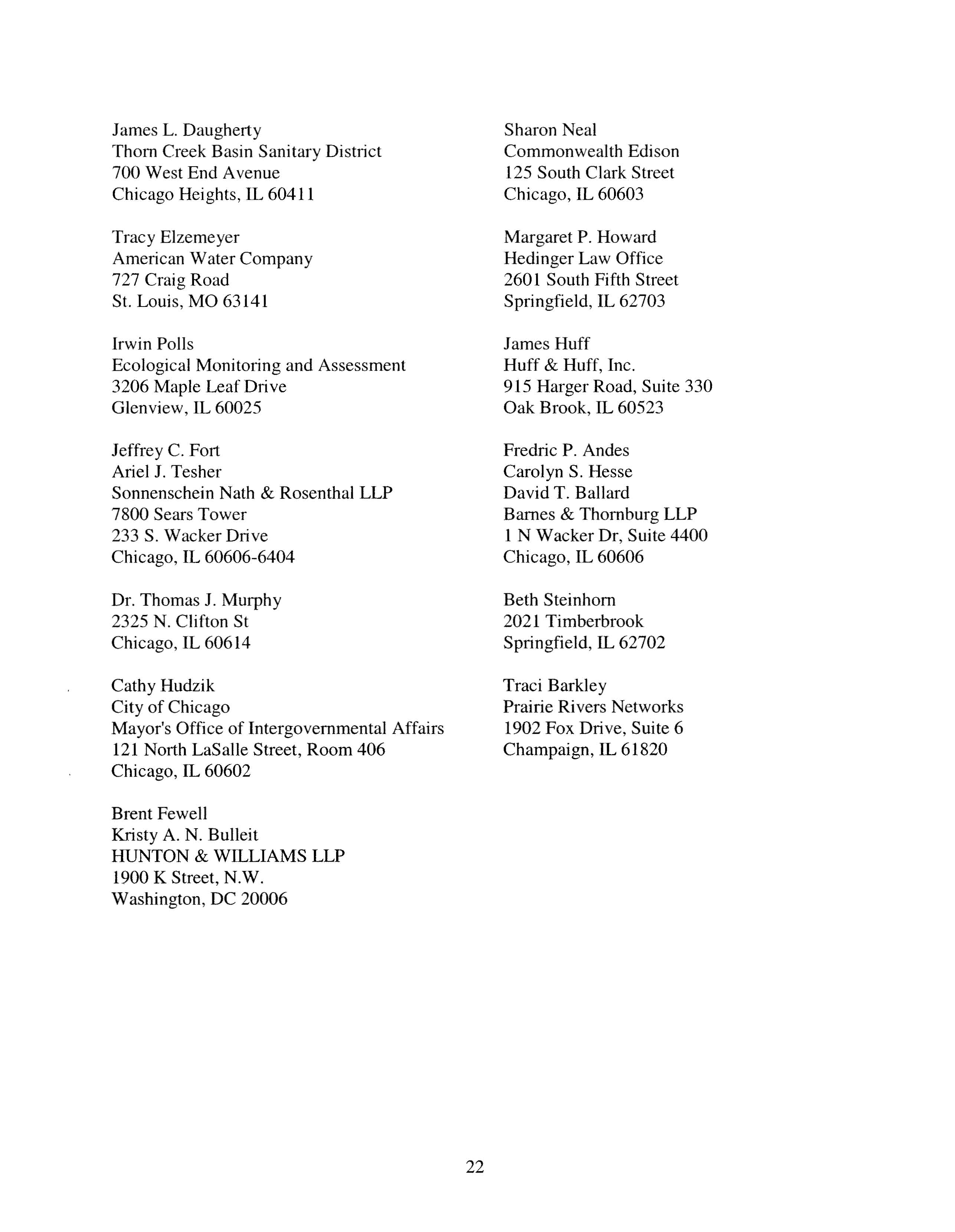BEFORE THE ILLINOIS POLLUTION CONTROL BOARD
IN THE MATTER OF:
WATER QUALITY STANDARDS AND
EFFLUENT LIMITATIONS FOR THE
CHICAGO AREA W ATERWAY SYSTEM
AND LOWER DES PLAINES RIVER
PROPOSED AMENDMENTS
TO 35 ILL.
ADM.
CODE 301, 302, 303, and 304
)
)
)
)
)
)
)
)
R08-9
(Rulemaking - Water)
NOTICE OF FILING
TO:
John Therriault, Clerk
Illinois Pollution Control Board
James
R. Thompson Center
100 West Randolph Street, Suite 11-500
Chicago, IL 60601
Deborah J. Williams, Assistant Counsel
Stefanie N. Diers, Assistant Counsel
Illinois Environmental Protection Agency
1021 North Grand Avenue East
P.O. Box 19276
Springfield,
IL 62794-9276
Marie Tipsord, Hearing Officer
Illinois Pollution Control
Board
James R. Thompson Center
100
West Randolph Street, Suite 11-500
Chicago,
IL 60601
Persons included on the attached
SERVICE LIST
PLEASE TAKE NOTICE that I have today filed with the Office of the Clerk of the
Pollution Control Board the
STEPAN COMPANY'S QUESTIONS FOR THE ILLINOIS
ENVIRONMENTAL PROTECTION AGENCY AT THE HEARING COMMENCING
JANUARY 28, 2008, a copy of which is herewith served upon you.
17
Electronic Filing - Received, Clerk's Office, January 18, 2008
Date: January 18,2008
Thomas
V. Skinner
Thomas
W. Dimond
Kevin Desharnais
Mayer Brown LLP
71 South Wacker Dl; ve
Chicago, Illinois 60606-4637
(312) 701-8079 (phone)
(312) 706-9181
(fax)
18
STEPAN COMPANY
Electronic Filing - Received, Clerk's Office, January 18, 2008
BEFORE THE ILLINOIS POLLUTION CONTROL BOARD
IN THE MATTER OF:
WATER QUALITY STANDARDS AND
EFFLUENT LIMITATIONS
FOR THE
CHICAGO AREA WATERWAY SYSTEM
AND LOWER DES PLAINES RIVER
PROPOSED
AMENDMENTS TO 35 ILL.
ADM.
CODE 301,302,303, and 304
)
)
)
)
)
)
)
)
R08-9
(Rulemaking - Water)
STEPAN COMPANY'S QUESTIONS
FOR THE ILLINOIS ENVIRONMENTAL PROTECTION AGENCY
AT
THE HEARING COMMENCING JANUARY 28, 2008
NOW COMES Stepan Company, by and through its attorneys, Mayer Brown LLP, and
submits the following questions based upon the Statement
of Reasons and its Attachments and
the testimony submitted by the Illinois Environmental Protection Agency ("Agency"
or "IEPA")
in this matter.
For Rob Sulski
1. On page 14 of your testimony you refer to intermediately tolerant and intolerant types of
aquatic life that are adaptive to the unique flow conditions of the Upper Dresden Island
Pool
("001 Pool"). Please describe what types of aquatic life are meant.
2. What are the unique flow conditions in the 001 Pool?
3.
Why are the geographic features of the 001 Pool (its earthen banks and overhanging
vegetation) given more weight than the effects
of upstream contamination in evaluating
the
001 Pool's aquatic life potential?
4.
Why was it determined that the UAA factors do not apply to the 001 Pool but do apply
to the
CAWS Aquatic Life Use A Waters and to the CAWS and Brandon Pool Aquatic
Life
Use B Waters?
a. In particular, for UAA factor number 3, how was it determined that there are no
ineparable human-caused conditions or sources of pollution that would prevent
the attainment
of the IEPA's recreational and aquatic life goals in the 001 Pool?
b. Also in regard to
UAA factor number 3, how was it determined that remedying
the sources
of pollution would not cause more environmental damage than
leaving them in place?
Electronic Filing - Received, Clerk's Office, January 18, 2008
c. Regarding UAA factor number 6, what studies were conducted to determine that
the economic impacts
of compliance would not result in an unacceptable social
impact?
d. Finally, regarding the remaining factors, how was it determined that there are no
other human or natural pollutants, dams, or other problems that might prevent
attainability
in the UDI Pool?
5. How are the Qualitative Habitat Index Evaluation ("QHEI"), Ohio Boatable Index, and
the IEPA Fish Index
of Biological Integlity ("IEI") calculated?
a. How do you explain the large difference in the scores between the Center of
Applied Bioassessment and Biocriteria ("CABB") QHEI scores for the DDI Pool
stretch
of 45 to 80 (Attachment S appears to show values of 43.5 to 81.5) and the
QHEI for the DDI Pool
of roughly 20 obtained in the UAA Final Report?
b. What was the basis for relying most heavily upon the CABB score?
c. What was the basis for discounting the UAA Final Report score?
d. Isn't the UAA Final Report score more reliable given that it calculated QHEIs at
over 30 locations along the UDI Pool whereas the CABB data only addresses 3
locations?
e. Was any narrative report describing the data summarized in Attachment S
prepared?
If
yes, will the Agency provide that to the Board and the parties in a
supplement filing?
If no narrative report was prepared, why not? Are the data in
Attachment S usable without a narrative report or someone to testify as to how the
data was gathered and what protocols were followed?
f. If
the correct score is 20, would that change the appropriate standards necessary to
protect the aquatic life?
6. How was it determined that waterway aeration, waterway flow augmentation, effluent
cooling, and effluent disinfection were recommended options for meeting the
temperature, bacterial, and dissolved oxygen standards?
a. What other options were considered?
b. Was any evaluation made into the feasibility
of these options for facilities other
than the MWRDGC?
c. Was any consideration given to what specific methods might be utilized by
facilities other than the MWRDGC?
If
so, was any consideration given to the
possible consequences
of those methods?
d. Was the cost of these options ever evaluated as to facilities other than MWRDGC
and Midwest Generation?
2
Electronic Filing - Received, Clerk's Office, January 18, 2008
e. According to your testimony (p. 18), the practicalities of MWRDGC's
compliance were considered. Why were similar analyses not performed for the
facilities along the Lower Des Plaines River? Are such analyses planned? Could
the results of those analyses impact !EPA's conclusions as to whether the revised
standards are technical1y feasible and economical1y feasible?
7. You say that temperature constraints could be overcome through additional cooling
of the
5 Midwest Generation stations. Do you also expect that other dischargers may exceed
the temperature limits and need to install additional cooling facilities? Have you
determined how many
wil1 be needed?
8. Will the current proposed bacteria standards resolve the bacteria violations associated
with storm events and combined sewer overflows ("CSOs")?
For Roy Smoger
1. How was it determined that the highest level of biological potential should serve as the
aquatic life goal for the UDI Pool?
a. Did you consider the impact of other lower-level areas upon the UDI Pool?
b. Did you consider whether the effluent concentration in the water flowing into the
UDI Pool from those other areas would render this high level
of biological
potential unrealizeable?
2. Does the UDI Pool currently meet the highest level of biological potential? If not, then,
according to your testamony (p. 3), what are the foreseeable improvements in its
conditions that will make the UDI Pool habitable by all types of aquatic life populations?
a. How did you determine what improvements are foreseeable?
b. Did you foresee that improvements in other areas
of the Lower Des Plaines River
would be necessary to enable the UDI Pool to reach the highest level
of biological
potential?
3. Considering your dissolved oxygen standards, did you conduct any studies to determine
whether, even
if the UDI Pool met your proposed standards, it would be habitable to
aquatic life?
If
so, what was the basis for that conclusion?
4. Why did the !EPA propose dissolved oxygen standards for the UDI Pool that are identical.
to those for General Use waters, when the UDI Pool has not been designated
as General
Use?
5.
If
the UAA Final Report QHEI score is correct and the aquatic life potential is poor, does
the daily DO standard need to be as high as 5.0 mg/l?
3
Electronic Filing - Received, Clerk's Office, January 18, 2008
For Scott Twait
1. On page 3 of your testimony, you state that "The Agency is also proposing water quality
standards for sulfate and chloride that are based
on the proposal currently before the
Board
in R07-9."
a. Why are water quality standards being proposed based on the proposed General
Water Quality standards for waters which have been determined to be unable
to
meet the General Water Quality Standards?
b. Have the differences for these waters been taken into account? How?
2. On pages 3-4 of your testimony, you state that the pH is being updated to conform to the
General Use standard
of 6.5 to 9.0. You further state,
"It
is expected that this standard
will
be attained at most times and in most areas of the CAWS and Lower Des Plaines
River, though data from the Metropolitan Water Reclamation District of Greater Chicago
(or MWRDGC) indicates there may be occasional pH violations below 6.5."
a. Are these violations expected due to natural variations in river/environmental
conditions?
b.
If
so, is it correct that the Agency does not expect that this pH standard is
consistently "attainable,"
as that term is used in 40 CPR 131.2.
c. Is it appropriate to designate uses which require establishment of standards where
it
is not expected that consistent compliance is possible?
3. The Agency says it is changing the pH to conform to General Use standards. Does the
Agency also, therefore, plan to change the NPDES discharge requirements to 6.5-9.0
in
future permits?
4. With regard
to ammonia, page 4 of your testimony states that the seasonal ammonia
standard protecting the early life stage period is not applicable to those waters not being
designated for the protection
of early life stages. The waters that do not protect for early
life stages are the CAWS and Brandon Pool Aquatic Life Use B waters.
a. Do the waters of the UDI Pool currently satisfy the proposed ammonia standard
for early life stages?
b. In establishing the ammonia standard for the UDI Pool, what factors support a
belief that ammonia levels will decline down stream
of the Brandon Locks?
c. Does the Agency know whether the waters of the UDI Pool currently meet the
proposed standards?
d. What percentage of waters which make up the UDI Pool originate in the Brandon
Pool? Has any analysis of the costs to achieve such compliance been undertaken?
4
Electronic Filing - Received, Clerk's Office, January 18, 2008
5. The proposed standard for ammonia is the same as General Use waters, yet the Lower
Des Plaines River cannot meet General Use. Explain why a standard different from the
General Use standard would not be more appropriate.
6. Page 5 of your testimony refers to several standards such as BTEX and others that were
pending approval by USEP
A. The attached letter states that by approving these criteria
the USEPA
is not endorsing IEPA's use of unreviewed static, unmeasured data in
deriving BTEX criteria. What does USEPA mean in this case?
7. If the drinking water standard for xylene is 10 ppm, why is the Lower Des Plaines
Chronic standard 0.36 ppm?
8. Why does the Agency propose General Use standards for chloride and sulfates for the
Lower Des Plaines River if it is not General Use, especially since the Agency says they
know there will be violations?
9. What are the current levels of chlorides and sulfates in the Lower Des Plaines River?
10. On page 10 of your testimony, you state, "Due to extreme difference of opinion in the
temperature discussion and the lack of
an updated national criteria document," IEPA
looked to the Ohio River Valley Water Sanitary Commission methodology for derivation
of temperature criteria.
a. What is the "extreme difference of opinion" mentioned?
b. Who were the parties who were in disagreement?
c. What was the basis for the opinion of each?
d. What other methodologies were considered for establishment of temperature
criteria?
11. On page 11 of your testimony, with regard to the MBI report's categories of
Representative Aquatic Species (RAS) lists, you state, "the categories are modeled after
existing aquatic life uses in lllinois and Ohio'smodified use, but should not
be
interpreted as being equivalent to existing Illinois and Ohio designated use labels."
a. How do the categories in the MBI report differ from the aquatic life use
designations developed by the Agency for the Lower Des Plaines River?
b. What is the significance of each identified difference?
c. How was each difference accounted for in establishing the applicable water
quality standards for the Lower Des Plaines River?
5
Electronic Filing - Received, Clerk's Office, January 18, 2008
12. On page 12 of your testimony, you state, "The Des Plaines River between Brandon Road
Lock and Dam and the I-55 bridge has incrementally more diverse aquatic life and higher
quality habitat than the rest
of the CAWS and Lower Des Plaines River. For this reason,
the Agency determined it was appropriate to use the option
of the 27 RAS list (Modified
Use) to determine the summer daily maximum and period average for the Upper Dresden
Island Pool waters."
a. What field studies, if any, were undertaken to confirm that the incremental
changes below the Brandon Road Lock and Dam would support the Modified Use
RAS list of species?
b. Was an evaluation undertaken for each species?
c. Which species are the drivers for derivation of the thermal standard?
d. Were any field studies undertaken to verify the appropriateness of these species as
indicator species for the subject portions of the Lower Des Plaines River?
13. On page 13 of your testimony, you state, "The monitoring location at Route 83 on the
Chicago Sanitary and Ship Canal was used as the 'background'location because it was
not directly influenced by cooling water or Lake Michigan and was believed to be
representative
of 'background'temperatures."
a.
It
this sampling point intended as background for the UDI Pool?
b. Do the characteristics of this location support its use as background for the UDI
Pool? How so?
14. On page
14
of your testimony you state, "the proposed thermal water quality standards
are also more stringent than the current General Use standards for the months
of April
through November, especially when considering the period average."
a. What is the basis for making the thermal standards more stringent on the affected
waterways than the General Use standard given that fish can tolerate short-term
elevations in temperature?
b. Does the Agency plan to change the General Use standards?
c. Has the Agency given notice to potentially affected dischargers outside the
CAWS and Lower Des Plaines River
of any intent to change the General Use
standard?
15. On page 14 of your testimony it appears the Agency adjusted the temperature limit based
on
MWRDGC's discharge temperatures. Will the Agency adjust other temperature limits
based on effluent discharge data from other facilities?
6
Electronic Filing - Received, Clerk's Office, January 18, 2008
16. What is the technical justification for the tenns of the proposed allowed excursions?
Have any studies been perfonned to detennine whether higher levels/numbers
of
excursions would impair the designated uses?
17. Has the Agency considered whether aquatic species in the
001 Pool have the ability to
engage
in adaptive behaviors in the face of temperature excursions in establishing the
proposed thennal standard?
a. For example, do the aquatic species have the ability to avoid areas with temporary
excursions by moving to other parts
of a water body?
b.
If
such behaviors have been considered, how are they reflected in the proposed
rule?
18. On page
16 of your testimony you refer to the study commissioned by MWRDGC and
the deferral
of adopting any numeric bacterial water quality standard ("WQS") until
sound infonnation
is available. The proposed disinfection standard may not be the right
standard and the expense
of installing systems may be unnecessary. How does the
Agency respond?
For Chris O. Yoder
1. Please provide for the record a complete copy of the MBI database, in searchable fonn
and a copy
of the Fish Temperature Model utilized to derive thennal endpoints from that
database.
2. What studies were considered but not included in the database? Please identify the
studies, and the basis for exclusion.
3. On page 7
of your testimony, you state, ""CTM is a rapid heating method that does not
approximate natural conditions and produces unrealistically high lethality endpoints."
Your testimony then continues, "Surprisingly, much of the new data that we found were
based on CTM studies." What percentage
of the over 200 new studies reviewed relied on
CTM endpoints? Did you examine whether the studies themselves included adjustment
factors to account for the differences from natural conditions?
4. On page 7
of your testimony, you indicate that, where new studies relied on CTM, "a
safety factor of 2°C was used ... to address the inherent weakness of this rapid heating
method in mimicking nature."
a. Isn'tit possible that test organisms would be able to acclimate and adjust better if
the temperature rise was more gradual such that the lethal endpoint would be
higher than recorded in
CTM studies?
b. What studies have you perfonned, or read, that address whether the 2°C
adjustment better reflects natural conditions?
7
Electronic Filing - Received, Clerk's Office, January 18, 2008
c. Was the combined effect of including this "safety factor" for each CTM study
considered
in calculating the short-term and long-term survival outputs?
d. How is this reflected in the study?
5. What percentage of the original 370 literature sources relied on CTM? Was the same
2°C adjustment applied to these studies? Was the combined effect of including the safety
factors considered? How is this reflected
in the study?
6. On page 8 of your testimony, you indicate that, due to your finding that intolerant species
are under-represented
in the thermal database, for these species you frequently rely on
single studies that do not always produce all of the thermal endpoints in the Fish
Temperature Model.
In order to address these "holes in the database," you rely on an
extrapolation procedure.
a. How may of the 27 RAS species selected for the 001 Pool required application of
this extrapolation procedure?
b. Doesn'tthe prevalence of this extrapolation procedure for "sensitive species"
suggest that the data most likely to determine the limits
of the study are inherently
the most unreliable?
c. How is the uncertainty resulting from this extrapolation reflected in the
assessment?
d. What steps have you taken to ensure that the extrapolation procedure does not
distort the results of your model, generally, and for the
001 Pool, in particular?
7. What methodology was utilized to define the Modified Use RASs for the 001 Pool?
8. Isn'tit true that the selection of the RAS species and the thermal endpoints selected for
each
RAS can potentially affect the overall outcome of the analysis?
9. Which species were considered but not included as Modified Use RASs?
10. What other species have been identified in the 001 Pool of the Lower Des Plaines River
which were not included in the Modified Use RASs?
11. Would inclusion of these additional species affect the results of the study?
12. In attachment 3 to your testimony, entitled, "Re-Evaluation of the Technical Justification
for Existing Ohio River Mainstream Temperature Criteria," prepared for ORSANCO,
dated January 27, 2006, (the ORSANCO Study) on pages 2-3, you state, "Temperature
criteria options that emanate from the Fish Temperature Modeling System are the result
of RAS selections and the thermal endpoints selected for each RAS. Thus, decisions
made about each can potentially affect the outcome
of the process." This is true for the
Lower Des Plaines River modeling
as well, correct?
8
Electronic Filing - Received, Clerk's Office, January 18, 2008
13. You state (Exhibit 3 at p. 3) that the list of representative fish in the ORSANCO study
was determined by a Subgroup
of the Ad Hoc Committee, which included members of
the regulated community and other stakeholders. How were the representative fish
species identified for the Lower Des Plaines River study? Was there a chance for input
on the selected species by members
of the regulated community or other stakeholders?
14. On page 9 of your testimony, you state, "It was left to the local and policy experts at
Illinois EPA to designate uses for the study area waters and make appropriate decisions
about the Representative Aquatic Species Lists." Is it your testimony that the selection of
the 27 Modified Use RASs for the UDI Pool of the Lower Des Plaines River was subject
to appropriateness review by the Agency? Could changes to the selected RASs alter the
thermal standards recommended by your study for the UDI Pool of the Lower Des
Plaines
Ri ver?
General Questions
1. Did the EPA consider the effect of increased recreational use on the disturbance of river
sediment and the degradation caused by this disturbance?
2. The Statement
of Reasons (p. 10) refers to the Board decision to designate the area from
Lockport to the I-55 Bridge as Restricted Use Waters because
of heavy industrialization,
barge traffic, diking
of the shoreline and dredging. What has changed to make this
different now?
3. The full implementation
of the Tunnel and Reservoir Project will not occur until 2015.
Since significant CSOs will continue to occur until completion
of that project, why
should we not wait for that to be completed before addressing bacteriologic issues?
a. With 15 CSO events per year, what makes the Agency think the effects from
these will not continue to affect the water quality?
b. Why should the regulations change now and therefore put more requirements on
the industlies rather than wait for installations
of the reservoir project in order to
reduce those events?
4. How does the Agency know that bacteria standards will bring the river into compliance
with the draft federal wastewater quality criteria
if the number of CSOs continues?
5.
If
there are concerns with health issues and public notification resulting from CSO
events, why increase the public use
of these segments until the CSO events are reduced?
6. In the Statement
of Reasons, you indicate 80% of the flow to the Brandon Locks comes
from wastewater treatment plants. How much flow in the UDI Pool area is attributed to
wastewater treatment plant discharges?
9
Electronic Filing - Received, Clerk's Office, January 18, 2008
7. The Statement of Reasons (p. 33) states, "[T]he Lower Des Plaines River is artificially
channelized, it is also routinely subject to unavoidable moderate to severe watercraft
passage related disturbances such
as sediment scouring and wake formation that is
dangerous to small watercraft and disrupts shoreline habitat for aquatic life."
a. Isn't IEPA's proposal to expand use designations for the Lower Des Plaines Ri ver
inevitably going to result in more incidents?
b. Did the Agency consider that expanded use designations could increase collisions
due to accidents or unsafe recreational users?
8. The Statement of Reasons (p. 34) states, "Each of the reaches possesses some physical
limitations to human-contact recreation ranging from: deep-draft, steep-walled channels,
to gradual sloped, manicured banks. Such limitations are irreversible in the foreseeable
future but, in combination with other factors described, preclude any activities from
occurring in these reaches other than those that currently exist."
If
this is the case, why
change the current standards?
9. On p. 42
of the Statement of Reasons, the Agency recommends deferring setting any
numerical standard for bacterial parameters for all three proposed recreational use
designations pending completion of additional studies. Why then propose a 304 bacterial
discharge standard?
10. On p. 43 of the Statement of Reasons, if fecal coliform is not an indicator organism and
USEPA has not published their bacteria criteria, why is the IEPA proposing the fecal
discharge requirement? Further, why is this discharge requirement proposed when
USEPA believes that fecal coliform bacteria are sometimes detected where fecal
contamination is absent?
11. Why not delay the proposed
304 bacteria standard until the USEPA establishes the
bacteria criteria since IEPA acknowledges they will return to the Board for a rulemaking
at that time?
12.
If
the MWRDGC is conducting a study over the next 24-30 months, why propose the 304
standards at this time?
13. On p. 48
of the Statement of Reasons, what is meant by aquatic life populations that are
intermediately tolerant? What types
of species are these?
14. On
p. 48 of the Statement of Reasons, what is meant by aquatic life populations that are
intolerant types and what types
of species are these?
15. On
p. 49 on the Statement of Reasons, what are the unique flow conditions mentioned to
which the aquatic life can adapt, and why are they able to adapt? What types
of species
are referred to here?
10
Electronic Filing - Received, Clerk's Office, January 18, 2008
16. Section 302.403 of 35 Ill. Adm. Code refers to unnatural sludge, and page 55 of the
Statement of Reasons says the Agency recognizes the history
of sediment pollution in the
CAWS and Lower Des Plaines River.
It
also says that historic sediment pollution
presents
an attainability concern to some types of aquatic life in these waters. What type
of aquatic life and what are the conditions and analysis of the sediment?
17. The Statement of Reasons (p. 69(e)) refers to the proposed standards for several chemical
constituents and says these are the same
as those for General Use waters. Why is this the
case
if the Lower Des Plaines River does not have the potential to attain General Use
status?
18. This section also says there are no national criteria for the parameters listed in (e) and that
the USEPA has not approved the Agency's standards. Specifically, for example, Xylene
has a
10 ppm level in drinking water but the proposal here is 30 times less. What is the
reasoning behind this far more stringent standard?
19. The Statement of Reasons (p. 75) refers to the sulfate and chloride standards and the
Agency proposes to adopt the General Use limits for the stream segments
in this
proposal.
If
the Lower Des Plaines River cannot reach General Use, why should the
proposed standard not be higher, especially since the Agency expects violations due
to
road salting? How will the Agency address NPDES permits for these two standards?
20. Section 302.410
of 35 Ill. Adm. Code addresses the setting of additional toxic standards.
This section should require the Agency
to propose those standards to the Board for
adoption
in order to allow input from all parties rather than deriving it independently.
Why did the Agency not follow those procedures in this case?
21. Regarding the ammonia standard, does the UDI Pool water meet the proposed standard?
When was the latest data generated?
22. Why adopt the General Use standard for ammonia for the UDI Pool if this segment does
not meet the General Use criteria currently?
Use
Designations
1. In what manner have the characteristics of the Lower Des Plaines Ri ver changed since
the early 1970's?
a. Did the Agency investigate how frequently the Lower Des Plaines River is
dredged presently?
b. Did the Agency investigate whether there has been a change in the frequency of
barge traffic on the Lower Des Plaines River?
c. Given the Agency's statements regarding the significance of CSOs, urban runoff
and industrial discharges, is the Lower Des Plaines River still subject
to
significant sludge deposition?
11
Electronic Filing - Received, Clerk's Office, January 18, 2008
d. Has there been any significant change in the slope or flow conditions of the
Lower Des Plaines River between the early 1970'sand the present?
e. Are the waters of the Lower Des Plaines River still subject to significant urban
stresses?
f.
Are the urban stresses even greater now due to increased population?
2. The Statement of Reasons (p. 22) states that the Agency's goal for the Lower Des Plaines
UAA was to "find an ecologically and recreationally attainable state that would as closely
as possible approach the aquatic life and recreational goals of the Clean Water Act
without causing
an adverse widespread socio-economic impact."
a. What did the Agency do to investigate the socio-economic impact of the proposed
new WQSs for the Lower Des Plaines
Ri ver?
b. Did the Agency evaluate whether additional uses proposed for the Lower Des
Plaines River are already provided on other nearby streams?
3. What is the meaning of the Agency statements at p. 24 of the Statement of Reasons?
Does the Agency possibly intend the uses and standards proposed in this proceeding to be
applied to waters outside the Lower Des Plaines River and CAWS?
4. Has the Agency reached a conclusion
as to whether the proposed 001 Pool Aquatic Life
uses are presently being attained in the entire stretch
of the Lower Des Plaines River
between the Brandon Road Locks and the I-55 bridge? What is the basis for that
conclusion?
5. Has the Agency reached a conclusion as to whether the proposed Incidental Contact
Recreation use is being attained in the entire stretch
of the Lower Des Plaines River
between the Brandon Road Locks and the I-55 bridge? What is the basis for that
conclusion?
Facilities Likely to be Impacted
1. Did the Agency seek information from industrial dischargers in the Lower Des Plaines
River as to the thermal quality
of their discharges and their ability to meet the proposed
WQSs without construction
of cooling towers or other cooling systems?
2. How many facilities does the Agency expect will be impacted by the proposed new
thermal standards for the
001 Pool?
3. Has the Agency considered the costs for industrial dischargers on the 001 Pool to
comply with the proposed new thermal standards?
12
Electronic Filing - Received, Clerk's Office, January 18, 2008
4. When the existing Secondary Contact standards were promulgated, the Board took into
account the costs that more stringent thermal standards would impose in terms
of tens of
millions of dollars of costs for required cooling towers. What has the Agency done to
consider similar costs in proposing these WQS changes?
5. Has the Agency's Bureau of Water consulted with the Bureau of Air as to the likely
increase
in particulate matter emissions that would result from the construction of cooling
towers to meet the proposed new thermal standards?
6.
If
the Agency has not conducted these inquiries, how can it conclude that the proposed
use designation does not cause more environmental damage than leaving the current use
designations in place (UAA factor 3) for the Lower Des Plaines River from Brandon
Road Locks to the I-55 bridge?
7. Has the Agency'sBureau
of Water considered whether cooling towers or other cooling
systems are capable
of being permitted under regulations applicable to air emissions
given the associated paIticulate matter emissions?
Thermal Standards
1. Does the UDI Pool water currently meet the proposed temperature standards?
a. During what periods of the year does the UDI Pool not meet the proposed
temperature limits?
b. How does the Agency plan to address NPDES permit holders whose discharges
into the UDI Pool are above the current proposed temperatures?
c. How, if it all, will allowed mixing and mixing zones be applied if the UDI Pool is
not attaining the finally adopted standards?
d. Since NPDES permits have monthly averages and maximums, how does the
Agency propose to address the IS-day proposed temperature limits in the
proposed standards during the times the Lower Des Plaines River does not meet
the standard?
2. The proposed thermal standards for the UDI Pool are the same
or tighter than General
Use. Does the Agency plan to change the General Use standards to match these?
If so,
shouldn'tthe Agency proceed with a change to the General Use standard prior to
adopting more stringent standards for waters that it admits cannot attain General Use due
to various UAA factors?
3. Given that the Agency's UAA did not find the Lower Des Plaines River to be capable
of
full attainment of the aquatic life and recreational goals of the CWA, why has the Agency
proposed thermal criteria that are even more stringent than standards applicable to
General Use waters?
13
Electronic Filing - Received, Clerk's Office, January 18, 2008
4. What was the scientific justification for using the 75
th
percentile as the monthly average
(Statement
of Reasons, p. 83)? What would the impact be of using a higher or lower
percentile?
Dissolved Oxygen
1.
The dissolved oxygen ("DO") standard being proposed for the 001 Pool is the same as
General Use. Why propose the same standards if the stream does not meet the necessary
standards to be classified
as General Use, especially given the contaminated sediment and
its affect
on the DO?
a. How does the Agency plan to enforce this standard on NPDES holders?
b. Is the OO! Pool currently attaining the proposed DO standard?
c. Can a mixing zone be used for DO discharges to the OO! Pool?
2. Given that IEPA has concluded that the Lower Des Plaines River from Brandon Road
Locks to the I-55 Bridge has not fully attained General Use status,
on what basis has
IEPA determined that the proposed dissolved oxygen standards should be the same
as
those for General Use?
3. Has the Agency determined which dischargers or how many dischargers will need to
provide additional treatment technology? Has the Agency considered the aggregate cost
of the additional treatment?
4. Is there evidence that early life stages are present in the 001 Pool during the March
through July time frame?
Stakeholder Involvement
1.
During the stakeholder involvement process, what, if any, proposed regulations on
possible temperature standards for the Lower Des Plaines River were discussed with the
stakeholders?
2. If any proposed regulations on temperature standards for the Lower Des Plaines River
were discussed, when were those discussed?
3. Why did the Agency propose the current regulations without another review with the
Stakeholders Advisory Group ("SAG")? Were the temperature standards proposed to the
Board presented to the SAG?
4. On what basis did the Agency change the proposed temperature standards between the
iast proposal to the SAG and what was proposed to the Board?
5. Did the Agency have any meetings or other communications with any stakeholders'
regarding the temperature criteria, use designations or other matters addressed
in this
rulemaking after January 2007?
If
not, why?
14
Electronic Filing - Received, Clerk's Office, January 18, 2008
Lower Des Plaines River Use Attainability Analysis Final Report
(AquaNova Int'l, Ltd.lHey & Associates, Inc., Dec. 2003)
(the "UAA Final
Report")
1. Why did the Agency not ask the authors of the UAA Final Report to address the
economic impact
of the changes in use designation? Does the Agency agree with the
statement in the UAA Final Report (p. 2-102) that such a study is "crucial"? If not, what
is the Agency's legal justification for ignoring one of the UAA factors set forth at 40
C.P.R.
§ 13l.lO(g)?
2. Despite admitting that it did not analyze one of the UAA factors, the UAA Final Report
concluded that the existing thermal standards should be replaced (p. 2-103). How could
the authors of the UAA Final Report legitimately reach that conclusion when they had
not analyzed a UAA Factor deemed "crucial"?
3. What steps has the Agency taken to assess whether compliance with the proposed
temperature criteria would cause greater environmental damage (UAA factor
3,40 C.P.R.
§ 131.lO(g)(3» than leaving the existing criteria in place?
4. The copy of the UAA Final Report posted on the Board'son-line docket is missing pages
2-98 through 2-101. Will the Agency agree to file those pages with the Board?
5. Does the Agency agree with the statements in the UAA Final Report (p. 4-12) that
vegetation in the UDI Pool is indicative
of a disturbed community and that industrial
development exists along much
of the UDI Pool segment of the Lower Des Plaines
River?
6. The UAA Final Report (p. 4-32 to 4-33) states that "navigation is listed as a 'typical'and
protected use" in 40 C.P.R. Part
131 and is a multi-million dollar industry of the Lower
Des Plaines River. Does the Agency agree with those statements?
7. What is the scientific legitimacy
of considering sub-aspects of the QHEI score as the
UAA Final Report does (pps. 4-30 to 4-34)?
Isn'tthe QHEI meant to be analyzed as an
aggregate score?
8. The UAA Final Report states (p. 4-33) that two habitat categories measured by the QHEI
"could be improved through artificial management."
a. What does this mean?
b. Does the Agency have plans to artificially change the use
of the UDI Pool
segment?
c.
If
so, on what basis is the Agency engineering a new use of the UDI Pool given
that the UAA Final Report concludes that poor habitat in the Lower Des Plaines
River is the "result of the channelization and impoundment of the river," which is
~onsidered
"irreversible" (p. 4-34)?
15
Electronic Filing - Received, Clerk's Office, January 18, 2008
Date: January 18,2008
Thomas V. Skinner
Thomas W. Dimond
Kevin Desharnais
Mayer Brown
LLP
71 South Wacker Drive
Chicago, Illinois 60606-4637
(312) 701-8079 (phone)
(312) 706-9181
(fax)
16
STEPAN COMPANY
Electronic Filing - Received, Clerk's Office, January 18, 2008
CERTIFICATE OF SERVICE
I, the undersigned, certify that on this 18
th
day of January, 2008, I have served
electronically the attached STEPAN COMPANY'S QUESTIONS FOR
THE ILLINOIS
ENVIRONMENTAL PROTECTION AGENCY AT THE HEARING COMMENCING
JANUARY 28, 2008, and NOTICE OF FILING upon the following person:
John Therriault, Clerk
Illinois Pollution Control Board
James
R.
Thompson Center
100 West Randolph Street, Suite 11-500
Chicago, IL 60601
and by U.S. Mail, first class postage prepaid,
to the following persons:
Malie Tipsord, Hearing Officer
Illinois Pollution Control Board
James
R. Thompson Center
100 West Randolph Street, Suite 11-500
Chicago, IL 60601
The participants listed on the attached
SERVICE LIST
Deborah
J. Williams, Assistant Counsel
Stefanie
N. Diers, Assistant Counsel
Illinois Environmental Protection Agency
1021 North Grand Avenue East
P.O. Box 19276
Springfield, IL 62794-9276
19
Electronic Filing - Received, Clerk's Office, January 18, 2008
SERVICE LIST
Frederick M. Feldman
Ronald M. Hill
Margaret T. Conway
Metropolitan Water Reclamation District
of Greater Chicago
III
East Erie Street
Chicago,
IL 60611
Bill Richardson,
Chief Legal Counsel
Illinois Department
of Natural Resources
One Natural Resources Way
Springfield,
IL
62702-1271
Keith Harley
Elizabeth Schenkier
Chicago Legal Clinic, Inc.
205 West Monroe, 4th Floor
Chicago,
IL 60606
Katherine D. Hodge
Monica
T.
Rios
Hodge
Dwyer Zeman
3150 Roland Avenue
P.O. Box 5776
Springfield,
IL
62705-5776
Dennis Duffield
Director
of Public Works & Utilities
City
of Joliet
921
E.
Washington St
Joliet,
IL
60431
Claire Manning
Brown
Hay& Stephens LLP
700 First Mercantile Bank Bldg
205 S. Fifth St
Springfield,
IL
62705-2459
Frederick Keady
Vermillion Coal Company
1979 Jolms Drive
Glenview,
IL
60025
20
Matthew Dunn,
Chief
Environmental Bureau
Office
of the Attomey General
100
West Randolph, 12th Floor
Chicago,
IL 60601
Ann Alexander
Natural Resources Defense Counsel
101 N. Wacker Dr., Ste. 609
Chicago,
IL
60606
Susan M. Franzetti
Franzetti
Law Firm P.e.
10 South Lasalle St.
Suite 3600
Chicago,
IL 60603
Albert Ettinger
Jessica
Dexter
Environmental Law & Policy Center
35 E. Wacker Dr., Suite 1300
Chicago,
IL
60601
Richard Kissel
Roy Harsch
DrinkerBiddle
191 N. Wacker Dr., Suite 3700
Chicago,
IL
60606~
1698
Charles Wesselhoft
James Harrington
Ross& Hardies
150 N. Michigan Ave
Chicago,
IL
60601-7567
Fred
L.
Hubbard
P.O. Box 12
16 West Madison
Danville,
IL
61834
Electronic Filing - Received, Clerk's Office, January 18, 2008
Georgia Vlahos
Naval Training Center
260lA Paul Jones St
Great Lakes, IL 60088-2845
W.C. Blanton
Blackwell Sanders LLP
4801 Main St, Suite 1000
Kansas City, MO 64112
Jerry Paulsen
Cindy Skukrud
McHenry County Defenders
132 Cass Street
Woodstock, IL 60098
Bernard Sawyer
Thomas Granto
Metropolitan Water Reclamation District
6001 W. Pershing Rd
Cicero, IL 60650-4112
Fredric Andes
Erika Powers
Barnes
&
Thornburg
1
North Wacker Dr
Suite 4400
Chicago, IL 60606
Bob Carter
Bloomington Normal Water Reclamation
PO Box 3307
Bloomington, IL 61702-3307
Kenneth W. Liss
Andrews Environmental Engineering
3300 Ginger Creek Drive
Springfield, IL 62711
Albert Ettinger
Jessica Dexter
Environmental Law
&
Policy Center
35 E. Wacker
Suite 1300
Chicago, IL 60601
21
Kay Anderson
American Bottoms
One American Bottoms Road
Sauget, IL 62201
Robert VanGyseghem
City
of Geneva
1800 South St
Geneva, IL 60134-2203
Albert Ettinger
Freeman Freeman
&
Salzman
401
N. Michigan Ave
Chicago, IL 60611
Lisa Frede
Chemical Industry Council
of Illinois
2250 E. Devon Ave
Suite 239
Des Plaines, IL 60018-4509
Jack Darin
Sierra Club
70
E.
Lake St
Suite 1500
Chicago, IL 60601-7447
Tom Muth
Fox Metro Water Reclamation District
682 State Route
31
Oswego, IL 60543
Vicky McKinley
Evanston Environmental Board
223 Grey Avenue
Evanston, IL 60202
Marc Miller
Jamie S. Caston
Office
of Lt. Governor Pat Quinn
Room 414 State House
Springfield, IL 62706
Electronic Filing - Received, Clerk's Office, January 18, 2008
James
L.
Daugherty
Thorn Creek Basin Sanitary District
700 West End Avenue
Chicago Heights, IL 60411
Tracy Elzemeyer
American Water Company
727 Craig Road
St. Louis, MO 63141
Irwin Polls
Ecological MonitOling and Assessment
3206 Maple Leaf Drive
Glenview, IL 60025
Jeffrey
C. Fort
Ariel
J.
Tesher
Sonnenschein Nath
&
Rosenthal LLP
7800 Sears Tower
233
S. Wacker Drive
Chicago, IL 60606-6404
Dr. Thomas
J. Murphy
2325
N. Clifton St
Chicago, IL 60614
Cathy Hudzik
City
of Chicago
Mayor's Office of Intergovernmental Affairs
121 North LaSalle Street, Room 406
Chicago, IL 60602
Brent Fewell
Kristy
A. N. Bulleit
HUNTON
&
WILLIAMS LLP
1900 K Street, N.W.
Washington, DC 20006
22
Sharon Neal
Commonwealth Edison
125 South Clark Street
Chicago, IL 60603
Margaret
P. Howard
Hedinger Law Office
2601 South Fifth Street
Springfield, IL 62703
James Huff
Huff
&
Huff, Inc.
915 Harger Road, Suite 330
Oak Brook, IL 60523
Fredric
P. Andes
Carolyn S. Hesse
David T. Ballard
Barnes
&
Thornburg LLP
1 N Wacker Dr, Suite 4400
Chicago, IL 60606
Beth Steinhorn
2021 Timberbrook
Springfield, IL 62702
Traci Barkley
Prairie Rivers Networks
1902 Fox Drive, Suite 6
Champaign, IL 61820
Electronic Filing - Received, Clerk's Office, January 18, 2008















